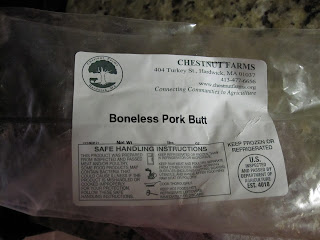I opened the blog today only to find I haven't posted anything since October! I am a bit shocked that I have let it wane, given that I am still eating three square meals a day, but I realize that most of those meals have been pretty dull. Boring. Not exciting enough for a blog post. Case in point: the only picture I could find of recent food adventures was this fried egg on sauteed potatoes and leeks. All of these ingredients come from New England and made a delicious, comforting feast, but not one I could write about in much detail...
Now that I am on spring break and not slogging to the office in sub-zero temperatures and snow, I will make it my mission to find better eats! We made carnitas last weekend, but it was so popular that I never had a chance to take a photo - only this sad shot of the pork before it was boiled and fried into submission. We head to England tomorrow, where delightful local foods await...stay tuned.
Carnitas:
I have spent years in New England searching for good carnitas.
While living in California, I became addicted to this heavenly pork dish (usually in tacos) and I am now ready to admit failure. I have not been able to find it here, so I have taken inspiration from my friend Cristie, who helped me make it at home using a recipe from
Smitten Kitchen.
3 pounds boneless pork shoulder or pork butt, cut into 2-inch cubes
1/2 cup orange juice
1/4 cup lime juice (from about 2 to 3 limes)
4 cloves garlic, peeled and crushed
1 teaspoon ground cumin
1 teaspoon Kosher salt, plus more to taste
Corn tortillas, for serving and avocado slices, cole slaw (Andrew makes his with a touch of tequila), and other fixings of your choice.
Place the pork in a large Dutch oven or heavy pot. Add the orange
juice, lime juice, garlic, cumin, salt and enough water to just barely
cover the meat. Bring the pot to a boil and then reduce the heat to a
simmer. Simmer uncovered for two hours. Don’t touch the meat.
After two hours, increase the heat to medium-high and while
occasionally stirring and turning the pieces, continue to cook for about
45 minutes, or until all of the liquid has evaporated, leaving only the
rendered pork fat. Let it sizzle in this fat long enough to brown at
the edges, turning pieces gently (they’ll be eager to fall apart), only
as needed.
When pork has browned on both sides, it’s ready. Adjust seasonings to taste and serve on warmed tortillas with fixings.


